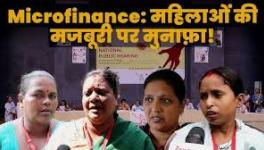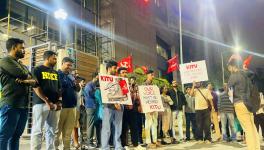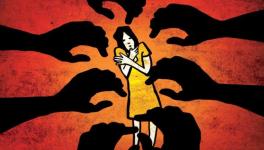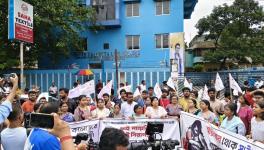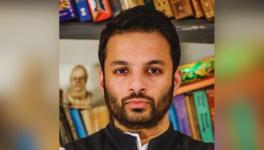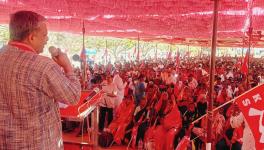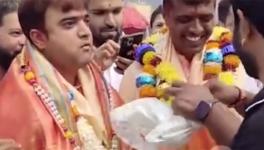“Death is For the Unmoving…”: K Neela on Lingayata Dharma and Vachana Sahitya
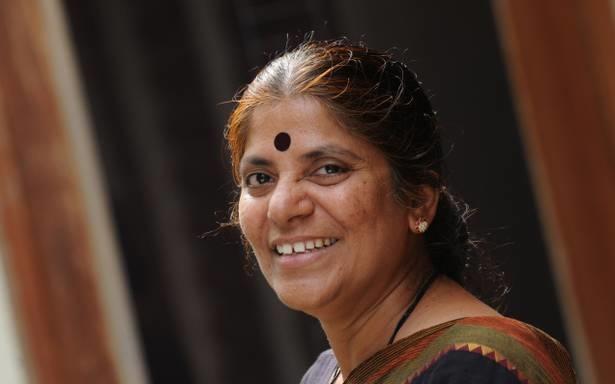
Image Courtesy: The Hindu
The Lingayat community in Karnataka has been struggling for about 40 years to get state recognition as separate from the Hindus. The movement is fast gaining momentum now. M M Kalburgi, who worked extensively on Vachana Sahitya, and Gauri Lankesh, who was a popular supporter of the movement, were both assassinated. Against this backdrop, the writer speaks to K Neela about the Lingayata Dharma and Vachana Sahitya. The article also throws light on how the Lingayata Dharma, which stood against the caste system, came to become a caste itself?
“Lingayat is not caste, but a tatva,” said K Neela. She is the Karnataka State Secretary of the All India Democratic Women's Association (AIDWA), a vocal feminist, activist, and a writer who draws her inspiration from both the Vachana literature of 12th century Karnataka and the leftist ideology. Quoting a few Vachanas, she spoke to this writer about the Lingayata Chaluvali (Lingayat Movement) in Karnataka, explaining its meaning and the ideology of the movement. She also spoke about how the Lingayata Dharma became Lingayata Jati (Caste).
The Lingayat Movement contends that the Lingayat community is not a part of Hinduism. According to Neela, it is very important to note that Hinduism has been successful in co-opting its critics. For example, Buddhism and Buddha are now claimed to be very much a part of Hinduism. The Vachanas, which are the backbone of the Lingayat belief system, were written to critique the oppressive social order that was, and still is, governed by Hinduism. As will be explained in this article, Vachanas also gave an alternative belief system which did not have some of the discriminatory practices, like prohibitions based on imagined “pollution,” that Hinduism imposed on its followers.
Explaining further, Neela says, “The Vachanakaras tell us that the whole world is a Linga. Those who take care of this Linga are called Lingayata.” She also clarifies, “‘Linga’, here, is not the same ‘Shiva Linga’ that is worshiped in Hinduism as another form of Shiva. ‘Linga’, for the Vachanakaras, is a small oval structure that represents the world and its composition. The world is nothing but our physical form, our bodies. Hence, those who take care of this whole world, i.e., of their own bodies, are Lingayats.” According to Neela, this is the essence of the Lingayat Philosophy. Thus, the philosophy does away with gods, temples, and the clergy.
The Vachanas preach that the world is formed by one’s body, hence, this body has to be worshiped. The Vachanakaras, the writers of the Vachanas, explain that it is only through Kayaka (work) that you can worship this body. When one puts the body to work, one legitimises its existence by giving it a purpose in life. Hence, Neela says, “The Vachanakaras say, ‘Kayakave pooje; nin kayadinda shristi yagide; ninna kayave devare, kayakave pooje.’ (Work is worship; the origin of the universe is by your body; your body is the only god, and the work you do is the offering you make to your body.)”
The essence of the Lingayata Dharma lies in this philosophy, propounded by Vachanakaras like Basavanna, Allama Prabhu, Akka Mahadevi, and Madivala Machideva. According to them, god and religion were created to exploit people by instilling an irrational fear in them. The paraphernalia of temples, priests, hymns — and the concepts of purity and pollutions that they prescribed — were seen as a means of exploiting the people. It was only the brahmins and the ruling castes who had the authority to govern this paraphernalia and draft the norms. The Vachanas challenged this authority, urging the masses to find the god within themselves.
ಉಳ್ಳವರು ಶಿವಾಲಯ ಮಾಡುವರು ನಾನೇನ ಮಾಡಲಿ ಬಡವನಯ್ಯ,
ಎನ್ನ ಕಾಲೇ ಕಂಬ ದೇಹವೇ ದೇಗುಲ ಶಿರವೇ ಹೊನ್ನ ಕಳಶವಯ್ಯ,
ಕೂಡಲಸಂಗಮದೇವ ಕೇಳಯ್ಯ ಸ್ಥಾವರಕ್ಕಳಿವುಂಟು ಜನ್ಗಮಕಲಿವಿಲ್ಲ
ullavaru shivalaya maaduvaru naanena maadali badavanayya,
enna kaale kamba dehave degula shirave honna kalashavayya
Koodala Sangama Deva kelayya sthavarakkalivuntu jangamakalivilla
-Basavanna
The rich can build a temple and worship in it.
What should a poor man like me do?
My feet are the pillars of the temple, my body is the temple,
and my head is the golden urn on the temple.
Oh my Koodala Sangama Deva, listen to me:
death is for the unmoving, and not for those who move.
This, for instance, is a famous Vachana by Basavanna, a philosopher, social reformer, and a preacher of 12th century. Basavanna was also a statesman in the court of King Bijjala the II (1130–1167 CE) of the Kalachuri dynasty. Basavanna critiqued and opposed the dominant brahmanical social order, caste system, and its oppressive vedic traditions. Speaking against the vedic rituals and brahminism, he took up the cause of the oppressed castes.
The importance given to the Kaya (body) and Kayaka (work) in Vachanas shows how the Vachanakaras were critical of the caste system and the hierarchical system that it imposed on the people. It was a call to work, to take care of the body, to maintain sanity; and not to please some god or any other person.
K Neela, while explaining this, draws an analogy between Marxism and the Vachana Sahitya. She says, “The importance given to work in the Vachana Sahitya comes very close to Marxism. Marx also said, ‘Workers of the world unite.’” The language of Marxism, of the importance given to the ‘worker’, also questions the exploitative system of production. The concept of alienation, for example, makes the ‘worker’ and their relationship with the processes of production as the focal point of analysis of exploitation. The contexts and concerns, for Karl Marx and the Vachanakaras, were quite different. In fact, they still are. While the former was writing in an industrial class society, the latter were writing in the medieval caste society.
The Vachanakaras were addressing a society where exploitation of the castes was given legitimacy using the idea of Karma. The Vachanas adopt a simple language, challenging the grammatical orthodoxy of Sanskrit. Using the language of the exploited, they deconstruct the reasons for exploitation, thereby successfully uniting the oppressed against the oppressor. This is the reason for the success of the Vachanas, according to Neela. The importance given to the Kaya and the Kayaka in the Lingayata Dharma gives importance to the physicality of the human existence.
The call, thus, was to be conscious about this physical existence. They also urged the masses to challenge and fight the forces that exploit the physical body and legitimise this exploitation by claiming that is it either by divine ordinance or the punishment for past misdeeds. “The Vachanas tell us that, for the Vachanakaras and the Lingayata Dharma, it was labour, production, and participation that were of utmost importance,” says K Neela.
Ironically, the philosophy that stood against the Jati system (caste system) is, now, considered a Jati (Caste) itself. The Lingayats make up 17% of the population of Karnataka. Lingayat has also been given an “Other Backward Caste” (OBC) status. The reason for this lies in a period of crisis in the history of the Lingayat Movement.
K Neela narrates:
It was difficult to put the theory into practice. Basavanna and other Vachanakaras decided to bring theory into practice. Basavanna celebrated the marriage of Sheelavanta, son of Samagar Haralayya (a cobbler), to Kalavati, the daughter of Madhuvaras (a brahmin). Both Haralayya and Madhuvaras belonged to the Sharana community. An inter-caste marriage between a brahmin girl and cobbler boy was brought to the notice of Bijjala the II. Basavanna, at that point, was his minister. When the king questioned him for supporting the marriage, he resigned from his position and left Basavakalyana, leaving his family behind.
Meanwhile, Haralayya and Madhuvaras were brutally executed. All the Sharanas and the followers of the Vachanakaras, including the Vachanakaras themselves, were attacked. Amidst all the chaos, King Bijjala the II was murdered and the Sharanas were, falsely, accused of the murder. The Vachanakaras had to go underground, and all of their scholarly works were destroyed.
The Vachana movement (which opposed Brahmanism), as a result, suffered unimaginable setbacks. There were many among the followers of the Vachanakaras who were ritualistic. They followed certain rituals of their own, like worshipping the Linga, which led to the powerful Brahmanical system categorising Lingayata as a Jati.”
The Lingayat Movement, today, is trying to reclaim this egalitarian legacy by revisiting its history through the vast Vachana literature.
Get the latest reports & analysis with people's perspective on Protests, movements & deep analytical videos, discussions of the current affairs in your Telegram app. Subscribe to NewsClick's Telegram channel & get Real-Time updates on stories, as they get published on our website.









